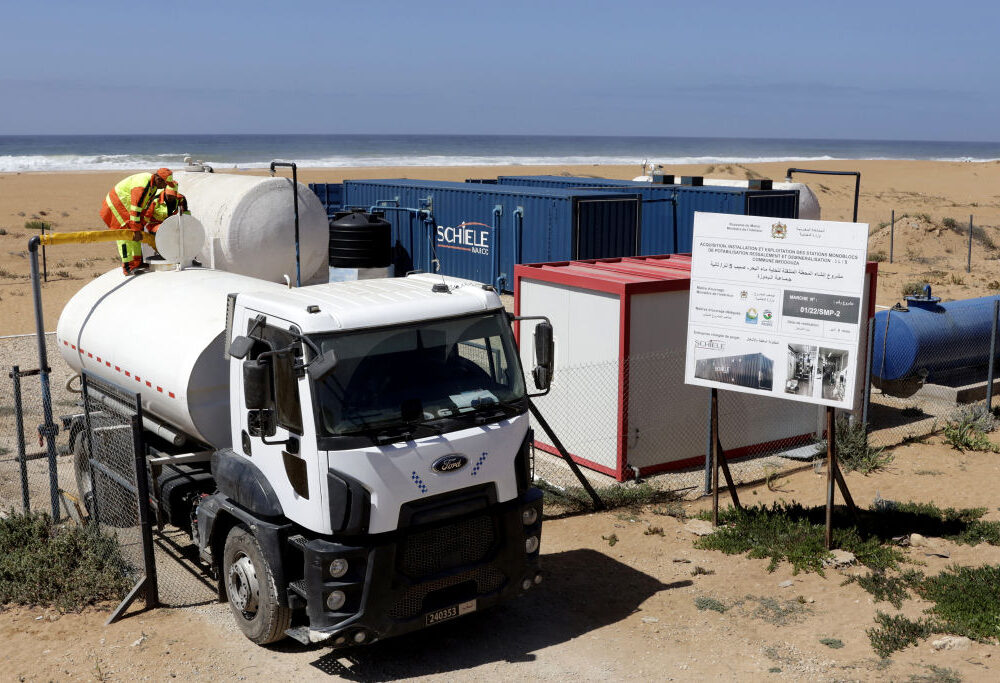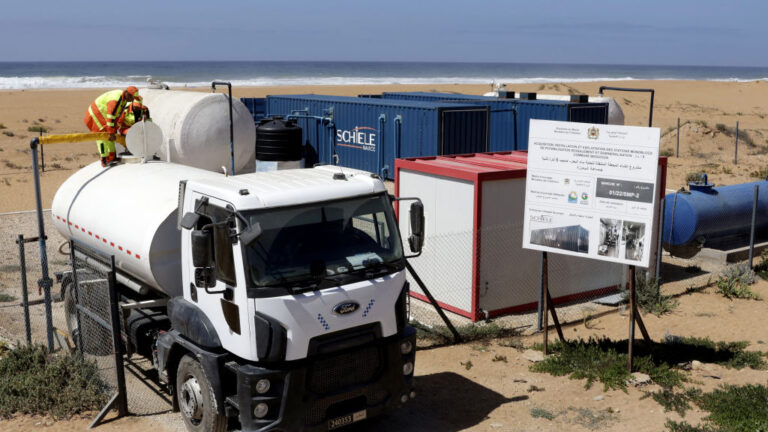Desalination system adjusts itself to work with renewable power
Instead of needing constant power, new system adjusts to use whatever is available.

Mobile desalination plants might be easier to operate with renewable power. Credit: Ismail BELLAOUALI
Fresh water we can use for drinking or agriculture is only about 3 percent of the global water supply, and nearly 70 percent of that is trapped in glaciers and ice caps. So far, that was enough to keep us going, but severe draughts have left places like Jordan, Egypt, sub-Saharan Africa, Spain, and California with limited access to potable water.
One possible solution is to tap into the remaining 97 percent of the water we have on Earth. The problem is that this water is saline, and we need to get the salt out of it to make it drinkable. Desalination is also an energy-expensive process. But MIT researchers led by Jonathan Bessette might have found an answer to that. They built an efficient, self-regulating water desalination system that runs on solar power alone with no need for batteries or a connection to the grid.
Probing the groundwaters
Oceans are the most obvious source of water for desalination. But they are a good option only for a small portion of people who live in coastal areas. Most of the global population—more or less 60 percent—lives farther than 100 kilometers from the coast, which makes using desalinated ocean water infeasible. So, Bessette and his team focused on groundwater instead.
“In terms of global demand, about 50 percent of low- to middle-income countries rely on groundwater,” Bessette says. This groundwater is trapped in underground reservoirs, abundant, and, in most places, present at depths below 300 meters. It comes mostly from the rain that penetrates the ground and fills empty spaces left by fractured rock formations. Sadly, as the rainwater seeps down it also picks up salts from the soil on its way. As a result, in New Mexico, for example, around 75 percent of groundwater is brackish, meaning less salty than seawater, but still too salty to drink.
Getting rid of the salt
We already have the ability to get the salt back out. “There are two broad categories within desalination technologies. The first is thermal and the other is based on using membranes,” Bessette explains.
Thermal desalination is something we figured out ages ago. You just boil the water and condense the steam, which leaves the salt behind. Boiling, however, needs lots of energy. Bringing 1 liter of room temperature water to 100° Celsius costs around 330 kilojoules of energy, assuming there’s no heat lost in the process. If you want a sense of how much energy that is, stop using your electric kettle for a month and see how your bill shrinks.
“So, around 100 years ago we developed reverse osmosis and electrodialysis, which are two membrane-based desalination technologies. This way, we reduced the power consumption by a factor of 10,” Bessette claims.
Reverse osmosis is a pressure-driven process; you push the water through a membrane that works like a very fine sieve that lets the molecules of water pass but stops other things like salts. Technologically advanced implementations of this idea are widely used at industrial facilities such as the Sydney Desalination Plant in Australia. Reverse osmosis today is the go-to technology when you want to desalinate water at scale. But it has its downsides.
“The issue is reverse osmosis requires a lot of pretreatment. We have to treat the water down to a pretty good quality, making sure the physical, chemical, or biological foul doesn’t end up on the membrane before we do the desalination process,” says Bessette. Another thing is that reverse osmosis relies on pressure, so it requires a steady supply of power to maintain this pressure, which is difficult to achieve in places where the grid is not reliable. Sensitivity to power fluctuations also makes it challenging to use with renewable energy sources like wind or solar. This is why to make their system work on solar energy alone, Bessette’s team went for electrodialysis.
Synching with the Sun
“Unlike reverse osmosis, electrodialysis is an electrically driven process,” Bessette says. The membranes are arranged in such a way that the water is not pushed through them but flows along them. On both sides of those membranes are positive and negative electrodes that create an electric field, which draws salt ions through the membranes and out of the water.
Off-grid desalination systems based on electrodialysis operate at constant power levels like toasters or other appliances, which means they require batteries to even out renewable energy’s fluctuations. Using batteries, in most cases, made them too expensive for the low-income communities that need them the most. Bessette and his colleagues solved that by designing a clever control system.
The two most important parameters in electrodialysis desalination are the flow rate of the water and the power you apply to the electrodes. To make the process efficient, you need to match those two. The advantage of electrodialysis is that it can operate at different power levels. When you have more available power, you can just pump more water through the system. When you have less power, you can slow the system down by reducing the water flow rate. You’ll produce less freshwater, but you won’t break anything this way.
Bessette’s team simplified the control down to two feedback loops. The first outer loop was tracking the power coming from the solar panels. On a sunny day, when the panels generated plenty of power, it fed more water into the system; when there was less power, it fed less water. The second inner loop tracked flow rate. When the flow rate was high, it applied more power to the electrodes; when it was low, it applied less power. The trick was to apply maximum available power while avoiding splitting the water into hydrogen and oxygen.
Once Bessette and his colleagues figured out the control system, they built a prototype desalination device. And it worked, with very little supervision, for half a year.
Water production at scale
Bessette’s prototype system, complete with solar panels, pumps, electronics, and an electrodialysis stack with all the electrodes and membranes, was compact enough to fit in a trailer. They took this trailer to the Brackish Groundwater National Research Facility in Alamogordo, New Mexico, and ran it for six months. On average, it desalinated around 5,000 liters of water per day—enough for a community of roughly 2,000 people.
“The nice thing with our technology is it is more of a control method. The concept can be scaled anywhere from this small community treatment system all the way to large-scale plants,” Bessette says. He said his team is now busy building an equivalent of a single water treatment train, a complete water desalination unit designed for big municipal water supplies. “Multiple such [systems] are implemented in such plants to increase the scale of water desalination process,” Bessette says. But he also thinks about small-scale solutions that can be fitted on a pickup truck and deployed rapidly in crisis scenarios like natural disasters.
“We’re also working on building a company. Me, two other staff engineers, and our professor. We’re really hoping to bring this technology to market and see that it reaches a lot of people. Our aim is to provide clean drinking water to folks in remote regions around the world,” Bessette says.
Nature Water, 2024. DOI: 10.1038/s44221-024-00314-6
Desalination system adjusts itself to work with renewable power Read More »

